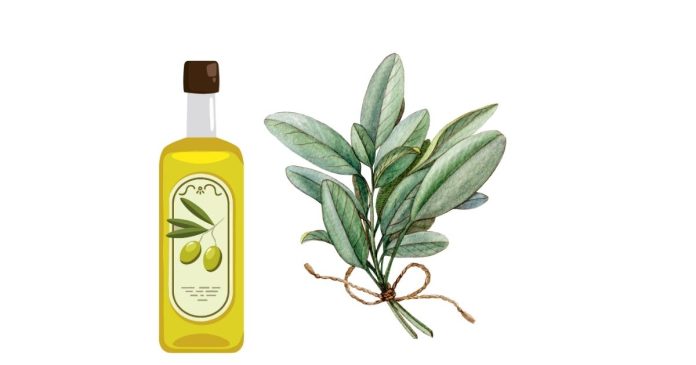When substituting rubbed sage for fresh sage, it’s important to understand the key differences between the two forms of this herb, both in terms of flavor intensity, texture, and culinary uses. Fresh sage is vibrant, tender, and aromatic, while rubbed sage is dried and crushed, concentrating its flavor and aroma. The conversion process from fresh sage to rubbed sage requires adjusting the quantity to ensure the correct balance of flavor in your dish.
Differences Between Fresh and Rubbed Sage
- Flavor Profile:
- Fresh Sage: Fresh sage leaves have a bright, slightly peppery, and earthy flavor with a slight minty undertone. The flavor is more delicate and subtle when used fresh.
- Rubbed Sage: Rubbed sage is dried and crushed, which intensifies its flavor. Dried herbs tend to be more concentrated, so the flavor is sharper and more pungent compared to fresh sage.
- Texture:
- Fresh Sage: Fresh sage has a soft and tender texture, which may wilt or soften during cooking, especially in wet dishes.
- Rubbed Sage: Rubbed sage is brittle and powdery due to the drying process, and it doesn’t contribute any texture to the dish.
- Culinary Uses:
- Fresh Sage is often used in recipes where its fresh, aromatic flavor can shine, such as in sauces, salads, roasted meats, or for garnishing.
- Rubbed Sage is ideal for seasoning dishes during cooking, particularly those where the herb will be incorporated into a mixture or simmered (such as soups, stews, stuffings and casseroles).
How to Substitute Rubbed Sage for Fresh Sage
When substituting rubbed sage for fresh sage, you’ll need to adjust the quantity because dried sage is much more concentrated in flavor. Here’s a general guideline for substitution:
- 1 tablespoon of fresh sage = 1 teaspoon of rubbed sage.
This ratio works well in most dishes, but it’s always a good idea to start with a smaller amount of rubbed sage, as its flavor can quickly overpower a dish. You can then taste and adjust as needed.
Step-by-Step Substitution
- Measure Fresh Sage: If your recipe calls for fresh sage, measure out the amount required (e.g., 1 tablespoon of chopped fresh sage).
- Use the Conversion Ratio: Use about 1 teaspoon of rubbed sage for every tablespoon of fresh sage required by the recipe.
- Add Early: Since dried sage has a stronger flavor, it’s best to add rubbed sage earlier in the cooking process so it has time to rehydrate and infuse the dish with flavor.
- Taste and Adjust: Because dried herbs are more potent, you may want to start with a smaller quantity, particularly if you’re unfamiliar with the strength of the rubbed sage you’re using. Add more if necessary, but be cautious not to overpower the dish.
Example:
If you’re making a stuffing and the recipe calls for 2 tablespoons of fresh sage, you can substitute it with 2 teaspoons of rubbed sage. Add the rubbed sage to the mixture early, as dried sage can benefit from the moisture in the stuffing to rehydrate and distribute its flavor more evenly.
Considerations When Substituting:
- Flavor Strength: Rubbed sage is stronger than fresh sage, so you may need to use less. If you want a milder flavor, err on the side of caution and use slightly less than the conversion suggests.
- Texture Differences: Fresh sage adds texture to certain dishes, particularly when chopped finely. If texture is an important part of the dish (for instance, in a salad or as a garnish), you may want to reconsider the substitution or opt for crushed fresh sage as an alternative to rubbed sage.
- Blending with Other Herbs: Rubbed sage has a strong and distinctive flavor, but in some recipes, it may blend better when paired with other herbs such as thyme, rosemary, or parsley. In such cases, you can add a complementary herb to balance the flavor.
Substituting Rubbed Sage for Fresh Sage in Specific Dishes
- Stuffing/Dressing: Since stuffing relies on the aromatic qualities of herbs, replacing fresh sage with rubbed sage will still work well. However, since rubbed sage is stronger, you may want to start with about half the amount and adjust after tasting.
- Soups and Stews: Rubbed sage works particularly well in soups and stews where the herb will have time to rehydrate and infuse the liquid. For each tablespoon of fresh sage, use about 1 teaspoon of rubbed sage.
- Roast Meats: For dishes like roasted chicken or pork where fresh sage is rubbed onto the meat or added to the cooking liquid, rubbed sage can be substituted effectively. However, it is advisable to use the smaller ratio and adjust the seasoning based on taste.
- Pasta Sauces: In pasta dishes where fresh sage is finely chopped and added to a sauce, rubbed sage can also work as a substitute. However, use it sparingly since it is potent.
Conclusion
Substituting rubbed sage for fresh sage is straightforward, but it requires a shift in the amount used due to the concentration of flavors in the dried herb. Generally, 1 teaspoon of rubbed sage can replace 1 tablespoon of fresh sage. As a rule of thumb, always start with less and adjust the seasoning to taste. This substitution will allow you to use dried sage effectively in your cooking, even if you don’t have fresh sage on hand.



